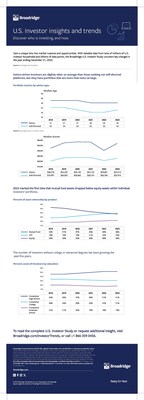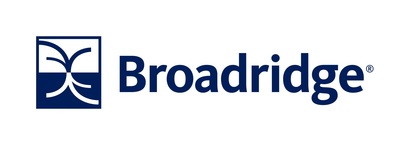Landmark Broadridge Study of More than 40 Million U.S. Retail Investors Highlights the Dramatic Shifts in How Americans Invest
The latest U.S. Investor Study from Broadridge Financial Solutions reveals key trends in American investment habits.
Self-directed assets have increased to 23% and investors without a college degree now exceed 50%.
ETF usage has surged from 31% in 2018 to 47% in 2023, and is expected to surpass 50% by 2025. Millennial investors are on course to outnumber Gen-X investors, with their count rising by 9 percentage points since 2018.
Female investors now have higher median assets than males, at $52,105 compared to $50,271.
The report also highlights a shift away from mutual funds toward ETFs and equities, particularly among younger generations.
Data from over 40 million U.S. retail investors across various asset classes was used to compile the study.
- Self-directed assets rose to 23%, indicating increased investor autonomy.
- ETF usage increased from 31% in 2018 to 47% in 2023, projected to exceed 50% by 2025.
- The count of Millennial investors rose by 9 percentage points since 2018.
- Female investors have higher median assets than male investors, at $52,105 versus $50,271.
- Younger generations are increasing their equity investments, with Millennials more than doubling their share from 2% to 6%.
- Mutual fund assets declined from 72% in 2018 to 62% in 2023.
- Assets held by Boomers and the Silent Generation are decreasing.
- Investors without a college degree hold significantly fewer assets, at $28,332, compared to $73,044 for college graduates.
Insights
Broadridge's study reveals notable shifts in investment behavior among U.S. retail investors, especially the rise in self-directed investing and the growing preference for ETFs and U.S. equities over mutual funds. These trends suggest a more informed and active investor base willing to take control of their investments. The increase in self-directed assets from
The data points to a democratization of investing, as more investors without college degrees enter the market. However, these investors still trail in median assets compared to those with higher education levels, highlighting a persistent inequality. The rise of Millennial and Gen-Z investors is also noteworthy, as their increasing share of assets represents a shift in market dynamics that financial advisors and asset managers must adapt to.
For retail investors, these findings underscore the importance of staying informed and considering diverse investment options. The trend towards self-directed investing provides opportunities to reduce costs and potentially increase returns by leveraging low-cost ETFs and equities.
The study's insights into demographic trends are particularly intriguing. The rise of Millennial investors and their increasing preference for self-directed investing and ETFs suggests a shift towards more personalized and cost-efficient investment strategies. This aligns with broader trends of digital transformation and the availability of financial information online. The fact that Millennials are growing their average number of investments faster than any other generation emphasizes their active and diversified investment approach.
Moreover, the steady decline in mutual fund ownership—down from
- Self-directed assets increase to
23% and the share of investors without a college degree exceeds50% - ETF usage rose to
47% from31% in 2018 and is likely to exceed50% by 2025 - The count of Millennial investors is on a path to overtake that of Gen-X investors, Millennial count increases by 9 percentage points since 2018
- Female investors have higher median assets than male investors at
$52,105 $50,271
Broadridge's
"The scope of this report demonstrates the dramatic changes we are seeing in the investment landscape as investor activity and sentiment continue to undergo tectonic shifts," said Dan Cwenar, Head of Broadridge Data and Analytics. "The rise of younger investors and self-directed investing has led to asset managers, broker-dealers and advisors evolving their practices to better serve a more diverse class of investors across generations. Against this backdrop, it's critical to have a complete understanding of investors' decision-making and appetite for different investments to better inform portfolio customization, customer service and prospecting. Our Study provides key insight into investor habits and sales channels, with the goal of delivering valuable data to inform investment product strategy and investment advice in the year ahead."
The monumental rise of self-directed investing as younger investors seize assets within the channel
Since 2018, there has been a significant surge in the number of investors adopting self-directed investing (online discount investing), with
This contradicts the widely assumed belief that self-directed investing is just for the young and less affluent. In fact, Broadridge's data shows that High-Net-Worth investors lean more heavily on self-directed investing compared to their Mass Market and Mass Affluent cohorts, with nearly
While all generations are leveraging self-directed investing, Gen-Z, Millennial, and Gen-X investors are steadily increasing their assets within the channel, collectively gaining 9 percentage points to
Alongside the rise of self-directed investing and the broader trend of the democratization of investing, this year's Study further exemplifies that younger, less experienced investors are capturing their own piece of the pie. The count of Millennial investors is on a path to overtake the count of their Gen-X predecessors, with the count of Millennials up by 9 percentage points since 2018, jumping from
The average number of investments held across generations continues to increase, with Millennials growing the fastest over a five-year period, increasing from six investments in 2018 to 10 in 2023.
Americans fall out of love with mutual funds as equity investments double
2023 marked the first time that mutual fund assets dropped below equity assets within individual investors' portfolios, with the share of investors owning mutual funds declining from
Boomers had the highest allocation to mutual funds in 2023 (
Additional key findings:
- Men make up more than half of investors (
51% ) and controlled55% of assets in 2023, up slightly from54% in 2018. The average male investor is three years younger than the average female investor and perhaps owing to their higher median age, female investors have slightly higher median assets ($52,105 $50,271 - The democratization of investing has been an overarching trend in asset management in the last decade, and the jump in the use of online discount brokers during the pandemic accelerated the shift. The share of investors without a college degree exceeded
50% for the first time in 2022, reaching51% in 2023. However, investors who only hold a high school degree still fall significantly behind those with higher levels of education in terms of median assets. Individuals without a college degree held$28,332 $73,044 $148,399 - The online discount channel has steadily won a larger share of assets over the last five years (jumping from
14% in 2018 to23% in 2023) and is on a trajectory to become the second largest distribution channel segment. The Broker-Dealer channel retains the top spot, although its market share has dropped7% since 2018.
Broadridge's
To view a summary of Broadridge's newest
Study Methodology
To create this study, Broadridge analyzed de-identified share ownership data derived from Broadridge's proprietary business processes consisting of tens of millions of retail investor households and billions of data points to achieve a unique level of insight into holdings invested through financial intermediaries (broker-dealers, online, RIAs, wirehouses). Broadridge analyzed exchange-traded funds (ETFs), closed-end funds, open-end mutual funds and
About Broadridge
Broadridge Financial Solutions (NYSE: BR), a global Fintech leader with over
For more information about us, please visit www.broadridge.com.
Media contact:
Matthew Luongo
Prosek Partners
+1 646-818-9279
mluongo@prosek.com
![]() View original content to download multimedia:https://www.prnewswire.com/news-releases/landmark-broadridge-study-of-more-than-40-million-us-retail-investors-highlights-the-dramatic-shifts-in-how-americans-invest-302152347.html
View original content to download multimedia:https://www.prnewswire.com/news-releases/landmark-broadridge-study-of-more-than-40-million-us-retail-investors-highlights-the-dramatic-shifts-in-how-americans-invest-302152347.html
SOURCE Broadridge Financial Solutions, Inc.









